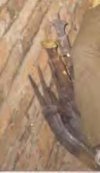- Joined
- Jan 26, 2002
- Messages
- 2,737
Re: khuk as wedge...
Thanks for your comments Tom. I agree that splitting tough wood in this fashion (as opposed to "precision splitting" to make cedar shakes for example) can cross the line to outright abuse. I was quite surprised by the intense handle vibration that can be produced if care is not exercised. I think I would say that if one holds the handle as tightly as one would when chopping while striking the spine with tha baton and feels shock/vibrations more powerful than those produced by proper chopping, the line has been probably been crossed. A couple light taps should help determine where to strike the spine to minimize vibrations/shock.
However, I don't know if that is enough to stay in the "safe zone" for a rat-tail tang. I feel would for a chiruwa tang, and I should probably get a 18-20" chiruwa AK to use when I expect a khuk to be a wedge. Sticking a partially split chunk of wood on the blade and slamming it down to split it is probably also best done with a chiruwa model. I wonder at what point the kamis would say: "What's wrong with you? Use an axe or a maul and wedge!"
Thanks for your comments Tom. I agree that splitting tough wood in this fashion (as opposed to "precision splitting" to make cedar shakes for example) can cross the line to outright abuse. I was quite surprised by the intense handle vibration that can be produced if care is not exercised. I think I would say that if one holds the handle as tightly as one would when chopping while striking the spine with tha baton and feels shock/vibrations more powerful than those produced by proper chopping, the line has been probably been crossed. A couple light taps should help determine where to strike the spine to minimize vibrations/shock.
However, I don't know if that is enough to stay in the "safe zone" for a rat-tail tang. I feel would for a chiruwa tang, and I should probably get a 18-20" chiruwa AK to use when I expect a khuk to be a wedge. Sticking a partially split chunk of wood on the blade and slamming it down to split it is probably also best done with a chiruwa model. I wonder at what point the kamis would say: "What's wrong with you? Use an axe or a maul and wedge!"

